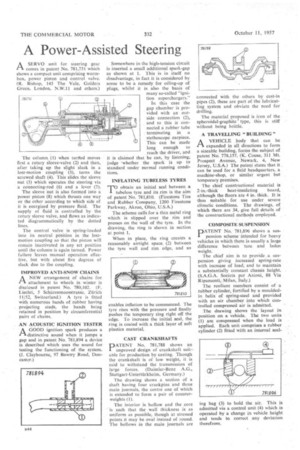A Power-Assisted Steering
Page 78

If you've noticed an error in this article please click here to report it so we can fix it.
A SERVO unit for steering gear I-1 comes in patent No. 781,751 which shows a compact unit comprising wormbox, power piston and control valve. (R. Bishop, 145 The Vale, Golders Green, London, N.W.H and others.)
The column (1) when turffed moves first a rotary sleeve-valve (2) and then, after taking up the slight slack in a lost-motion coupling (3), turns the screwed shaft (4). This slides the sleeve nut (5) which operates the steering via a connecting-rod (6) and a lever (7).
The sleeve nut is also formed into a power piston (8) which thrusts one way or the other according to which side of it is energized by pressure fluid. The supply of fluid is controlled by the rotary sleeve valve, and flows as indicated diagrammatically by the dotted lines, The control valve is spring-loaded into its neutral position in the lostmotion coupling so that the piston will remain inactivated in any set position until the column is again turned. Power failure leaves manual operation effective, but with about five degrees of slack due to the coupling.
IMPROVED ANTI-SNOW CHAINS
-1-1 A NEW arrangement of chains for attachment to wheels in winter is disclosed in patent No. 780,102. (F. Liechti, 5 Scharenmoosstrasse, Zurich 11/52, Switzerland.) A tyre is fitted with numerous bands of rubber having projecting studs, the bands being retained in position by circumferential pairs of chains.
AN ACOUSTIC IGNITION TESTER A GOOD ignition spark produces a distinctive sound when it jumps a gap and in patent No. 781,894 a device is described which uses the sound for testing the functioning of the system. Claybourne, 97 Bawtry Road, Doncaster.)
Somewhere in the high-tension circuit is inserted a small additional spark-gap as shown at 1. This is in itself no disadvantage, in fact it is considered by some to be a remedy for oiling-up of plugs, whilst it is also the basis of many so-called "ignition superchargers."
In this case the gap chamber is provided with an outside connection (2), and to this is connected a rubber tube terminating in a stethoscope earpiece. This can be made long enough to reach the driver, and it is claimed that he can, by listening, judge .whether the spark is up to standard under nurmal running conditions.
INFLATING TUBELESS TYRES obtain an initial seal between a tubeless tyre and its rim is the aim of patent No. 781,810. (Firestone Tire and Rubber Company, 1200 Firestone Parkway, Akron, Ohio, U.S.A.) The scheme calls for a thin metal ring which is slipped over the rim and presses on the wall of the tyre. In the drawing, the ring is shown in section at point 1.
When in place, the ring creates a reasonably airtight space, (2) between the tyre wall and rim edge, and so enables inflation to be commenced. The tyre rises with the pressure and finally pushes the temporary ring right off the edge. To increase the initial seal, the ring is coated with a thick layer of soft plastics material.
CAST CRANKSHAFTS
PATENT No. 781,788 shows an i improved design of crankshaft suit-able for production by casting. Though the crankshaft is of low weight, it is said to withstand the transmission of large forces. (Daimler-Benz A.G., Stuttgart-Unterttirkheim, Germany.)
The drawing shows a section of a shaft having four crankpins and three main journals, the centre one of which is extended to form a pair of counterweights (1).
The interior is hollow and the core is such that the •wall thickness is as uniform as possible, though at stressed points it may be oval instead of round. The hollows in the main journals are connected with the others by cast-in pipes (2), these are part of the lubricatting system and obviate the need for drilling.
The material proposed is iron of the spheroidal-graphite type, this is stiff without being brittle.
A TRAVELLING " BUILDING "
PAA VEHICLE body that can be expanded in all directions to form a sizeable building, forms the subject of patent No. 778,157. (K. Couse, 311 Mt. Prospect Avenue, Newark, 4, New Jersey, U.S.A.) The patent states that it can be used for a field headquarters, a machine-shop, or similar urgent but temporary premises.
The chief constructional material is 2-in.-thick heat-insulating board, although the floors are 4 in. thick. It is thus suitable for use under severe climatic conditions. The drawings, of which there are 34, give full details of the constructional methods employed.
COMPOSITE SUSPENSION
DATENT No. 781,896 shows a sus
pension scheme intended for heavy vehicles in which there is usually a large difference between tare and laden weight.
The chief aim is to provide . a suspension giving increased spring-rate with increase of load, and to maintain a substantially constant chassis height. (S.A.G.A. Societa per Azioni, 88 Via Ripamonti, Milan, Italy.) The resilient members consist of a rubber cylinder, fortified by a mouldedin helix of spring-steel and provided with an air chamber into which controlled compressed air is admitted.
The drawing shows the layout in position on a vehicle. The two units (I) are compressed when the load is applied. Each unit comprises a rubber cylinder (2) fitted with an internal seal ing bag (3) to hold the air. This is admitted via a control unit (4) which is operated by a change in vehicle height and tends to correct any deviation therefrom.




















































































































